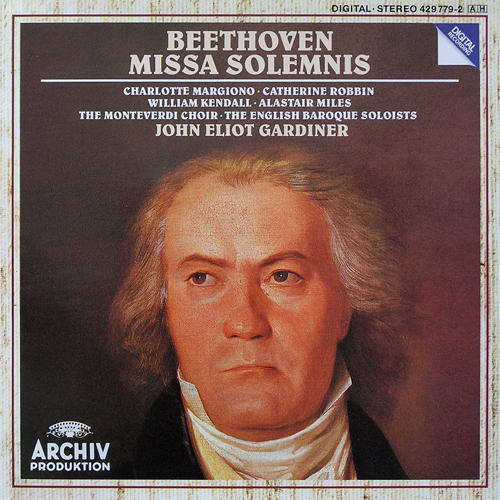|
|
|
01 |
Kyrie - Assai sostenuto |
|
|
|
08:51 |
|
|
02 |
Gloria - Allegro vivace |
|
|
|
16:29 |
|
|
03 |
Credo - Allegro ma non troppo |
|
|
|
17:28 |
|
|
04 |
Sanctus - Adagio |
|
|
|
15:16 |
|
|
05 |
Agnus Dei - Adagio |
|
|
|
13:34 |
|
|
|
| Country |
United Kingdom |
| UPC (Barcode) |
3421710445801 |
| Packaging |
Jewel Case |
| Spars |
DDD |
| Sound |
Stereo |
|
| Soprano |
Charlotte Margiono |
| Mezzo-soprano |
Catherine Robbin |
| Tenor |
William Kendall |
| Bass |
Alistair Miles |
|
| Conductor |
John Elliot Gardiner |
|
Mass for soloists, chorus & orchestra in D major ("Missa Solemnis"), Op. 123
Composer Ludwig van Beethoven
Composition Date 1819-1823
Composition Description by Wayne Reisig
Past 50, Beethoven found himself deaf, eluded by true love, rejected by the nephew for whom he had assumed a paternal role, plagued by myriad illnesses. And yet, at that point in his life, the composer wrote on the score of his Missa Solemnis, "to my God, who has never deserted me." What inner state brought humility forth from this Promethean figure, a recognition and awe of one's place in the cosmos from this fervent, defiant advocate of the dignity of humankind? In his faith he was as unshakable as Bach or Bruckner, but it was a faith forge-tempered by this inner state and fed by nature more so than scripture and spire. It was reflected in this opus 123 mountain-cathedral from the last great period which also saw the Ninth Symphony and the last quartets. Ironically, the disposition of the great mass was as earthbound as any promotional process, with the composer touting it as "the greatest work which I have composed thus far" to lure back publishers who had become wary of some of Beethoven's less ethical dealings. Here, it would seem, his word is genuine. With the "Alle Menschen" of the Ninth Symphony, the twin summits of the two mighty late works form a yin-yang of the composer's deeply held beliefs.
The composition of the great mass occupied Beethoven from 1818 to 1823, taking it well past the occasion for which it was composed, the installation of the Archduke Rudolph as Archbishop of Olmu"tz. To prepare, Beethoven immersed himself in church music history for one year. The result was the essence of the composer, reverently looking back while forging ahead. In addition to soloists and chorus, the mass utilizes an organ and expanded orchestra. The five main sections of the ordinary of the Roman Catholic mass are subdivided. The opening Kyrie is marked by dramatic ebb and flow, the interaction of chorus and soloist thoroughly integrated. This is followed by the jubilant Gloria, its unbridled ecstasy initially considered unsuitable for service, with virtual shouts of Gloria forming the coda. In the Credo, this core of the Catholic faith, Beethoven utilizes old church modes in harness with his own then-modern music idiom and employs these for vivid tone painting. A warmer ecstasy pervades the Sanctus; here is Man, childlike, reaching for the Creator; perhaps the most beautiful moment occurs in its Benedictus; the effect of the solo violin is like that of a long-sought peace, descending upon and infusing the soul like balm. The Agnus Dei commences dark and brooding, later becoming, ironically, martial in the Dona nobis pacem and the listener is reminded that nearly two decades of continental war had but recently came to a close. The soloists have the final impassioned word, Beethoven ending his mass with an affecting plea for universal peace.
